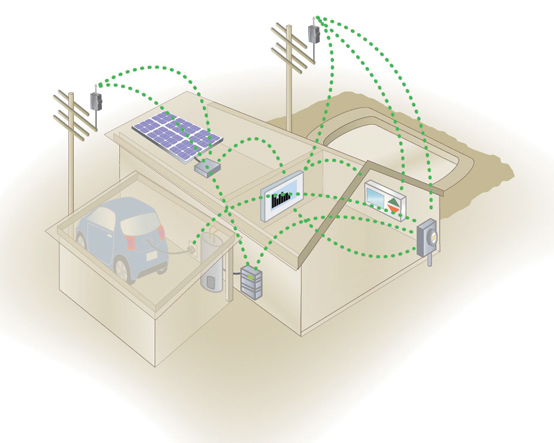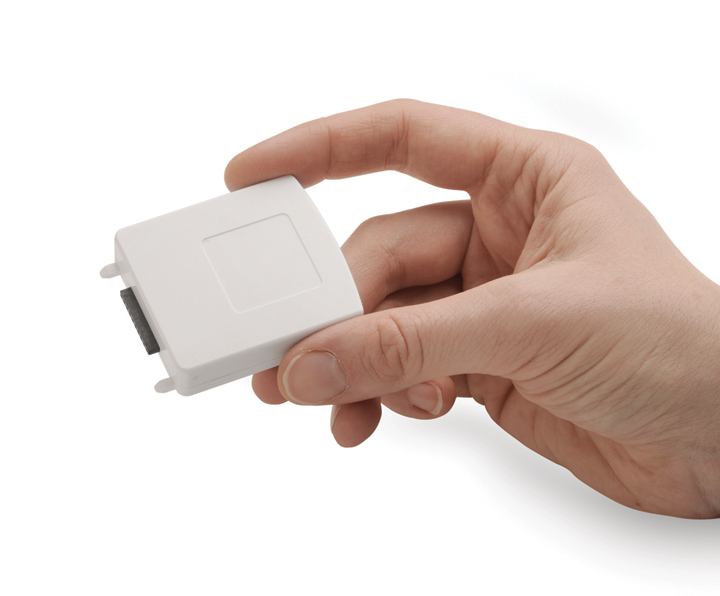According to a recent report from ON World, a research firm providing business intelligence on smart technology markets, 100 million smart meters will be deployed in the next five years. The report goes on to predict that half of those meters will have a built-in Home Area Network (HAN) gateway for in-home energy management programs and services1. The HAN enables energy efficiency, demand response, and direct load control in a Smart Grid deployment. Behavioral energy efficiency utilizing real-time meter data, technology-enabled dynamic pricing, and deterministic direct load control are examples of demand-side management (DSM) applications that are enabled by a high bandwidth, two-way, end-to-end Smart Grid communications network. A Smart Grid that incorporates energy efficiency and demand response increases its value as a long-term infrastructure investment and reduces the time required to achieve a satisfactory return on investment. This article will examine two HAN gateway architectures – integration into the smart meter and the dedicated in-home gateway device.

Nathan Ota
Trilliant Inc.
Redwood City,
California USA
May I have a HAN gateway, please?
The term “HAN gateway” as used here refers specifically to the function that interfaces the HAN with the neighborhood-area network (NAN), which interconnects meters together into an advanced metering infrastructure (AMI) network. A HAN gateway can also apply to the physical device dedicated to performing this function. Both ZigBee and OpenHAN – standards frequently considered for implementing these networks – recognize the need to support the HAN gateway function, but do not make specific recommendations for where this function should reside, leaving that choice to the utility.
In these types of projects, there are two prevailing choices that the utility must make: 1) Should the HAN gateway be integrated into the smart meter that communicates with the NAN, or 2) should the HAN gateway function reside in the home in some other device? The utility may or may not care about the specific in-home device employed, but will certainly care about its effect on the Smart Grid business case.

Home Area Network (HAN) Architecture
HAN Integration in the Smart Meter or Meter Portal
One obvious way to ensure end-to-end, two-way communications between the utility and the residential subscriber is to have the smart meter become a node on the HAN. In this architecture, referred to here as the Meter Portal, the meter would contain separate NAN and HAN radios – both under the glass – with the HAN gateway function interfacing the two. This Meter Portal architecture is well suited for homogenous and ubiquitous mass deployment of stable HAN technology. The major advantage of this design is that it enables the utility to control exactly how the HAN interfaces with the NAN, the latter being the network used to communicate with all smart meters.
Separate HAN Gateway or HAN Device Portal
This architecture involves locating the HAN gateway function in the home in a designated device, potentially a standalone unit devoted exclusively to this function. This design does not require a separate dedicated device if the HAN gateway function is integrated into a required device, such as a programmable thermostat or in-home display. Whether dedicated or integrated, the in-home device would need to contain separate NAN and HAN radios just as with the Meter Portal.
This architecture – referred to here as the HAN Device Portal – has numerous advantages and offers a flexible, incrementally-deployable solution that is well-suited to supporting a heterogeneous set of evolving HAN technologies, while continuing to afford the utility control over communications with the NAN. Note that both the Meter Portal and HAN Device Portal architectures provide equitable access across the utility’s service area, meaning that HAN-based applications can reach everyone with a smart meter.
The difference, however, is that in the Meter Portal architecture, a HAN gateway must be installed with every smart meter; whereas with the HAN Device Portal, the HAN gateway can be deployed either at the time of the smart meter installation or at another date in the future.
Comparing the Architectures
While numerous criteria are often invoked for making architectural comparisons, these four are of particular importance in residential DSM applications:
- Cost Implications
- Communications Capability
- Support for Market Innovation
- Risk Mitigation
Cost Implications
In both architectures, the minimum number of radios needed to interface the HAN with the NAN is three: two in the meter (NAN and HAN) and one in a home device (HAN) for the Meter Portal; or one in meter (NAN) and two in the home device (HAN and NAN) for the HAN Device Portal. With a prudent choice of radio technology for both the NAN and the HAN, the cost for all three radios is comparable. Using the same basic radio technology, such as IEEE 802.15.4, also has the potential for significant cost reductions through volume deployments. Choosing a popular standard such as IEEE 802.15.4 has the additional advantage of even greater economies of scale as these technologies become more widespread for other applications.
An advantage of the HAN Device Portal architecture is that it permits an incremental, pay-as-you-go approach to implementing DSM programs for residential customers, even when deployment is expected to be universal over the long term. The cost for initial trials or pilots remains low, while the approach continues to present the opportunity for cost minimization through volume during full-scale deployment. Initially, the HAN Device Portal is deployed only to those consumers opting into the energy efficiency or DSM program, such as demand response or direct load control. Depending on the utility’s specific program, the HAN gateway function can be implemented in some device already required, such an in-home display, programmable communicating thermostat or direct load controller. This pay-as-you-go approach is unlike the Meter Portal architecture, where the cost-effectiveness of the business case is biased toward full deployment to every consumer, independent of actual participation in any program.
Although HAN technologies are optimized for low cost, the sheer number of homes involved – with relatively few participating in DSM initially – may favor deploying the HAN gateway function in a dedicated consumer device. In fact, the percentage of homes actually utilizing a meter’s integral HAN gateway may be quite small for many years. The previously referenced ON World report also predicts there will be only 20 million HAN-enabled households worldwide by the end of 2013. An extrapolation of the data reveals there could be upwards of 30 million smart meters with their built-in HAN capabilities going unused for an extended period. By incurring the cost of the HAN gateway only for those customers participating, as with the HAN Device Portal, the utility stands to achieve a far better return on investment in both the short and longer term.
Communications Capability
The HAN Device Portal architecture affords superior communications capabilities based on the differences in fundamental operational characteristics for neighborhood-area and home-area networks. NANs are designed to operate over greater distances in outdoor environments, whereas HANs are designed to operate at a much shorter range indoors. Indeed, the basic IEEE 802.15.4 framework for HANs conceives a 10-meter (33 foot) communications area, and ZigBee communications utilize transmit powers ranging from a relatively low 1 mW to 100 mW. The shorter range is not a limitation in the HAN, and this intentional characteristic affords the additional benefits of conserving power consumption and keeping costs low, which are both desirable and appropriate in large-scale energy management applications.
Given the fundamental differences in operational characteristics of NANs and HANs, the HAN Device Portal, with its built-in NAN, enjoys an advantage because it can more readily communicate over a considerable distance with the outdoor NAN. For the outdoor Meter Portal to communicate effectively with the indoor HAN, however, it is necessary to overcome some inevitable challenges.
For example, consider just these three common scenarios: a rural home where the meter may be hundreds of feet from the house; a high-rise multi-tenant unit where the meters are in the basement; and a suburban neighborhood where meters may be located behind reinforced concrete walls or other obstacles to make them less obtrusive. With its built-in NAN radio, the HAN Device Portal is capable of providing the long-range communications required in all three scenarios. For the Meter Portal to overcome the RF signal loss caused by the distances and/or attenuation involved in each scenario, additional equipment such as a HAN repeater may be required.
Support for Market Innovation
The market for HAN involves a growing variety of applications and vendor solutions. Moreover, the global nature of this market also affords tremendous opportunities for innovation, and of course, utilities will want to be in a position to leverage this innovation as much as possible.
Consumers (and utilities) have a choice of several different home area networks, including: 6LoWPAN, FlexNet, HomePlug, LonWorks, Radio Data System (RDS), Wi-Fi, Z-Wave and ZigBee. The choices now available for both home networking and power supply combine to have an impact on the choice of HAN gateway architecture.
Residential consumers are increasingly given a choice of power sources, and these retail suppliers of electricity may have their own demand-side management programs, complete with a recommended or required HAN solution. The permutations and combinations of supplier and technology choices have the potential to create an unwieldy situation in some markets. Home energy management devices, many of which use Z-Wave, are now available through retail channels, and some customers are deploying these in advance of any DSM program from their local utility.
This market dynamic creates an advantage for the HAN Device Portal architecture, derived from the modular design possible in a consumer device. Such modularity is beneficial during the design and manufacturing stages, and can also be extended to the retail environment or even into the home with special plug-in modules, such as those conforming to the Utility Smart Network Access Port (U-SNAP).
By having a modular design, HAN Device Portals can be upgraded, replaced, reconfigured or otherwise changed as needed – by either the manufacturer, the consumer, or both – to take full advantage of advances or changes in technology at any time. A U-SNAP module could be used in the meter, of course, but because the radio is under the glass, the only way to support different HANs would be to deploy different versions of the meter. In addition, any changes to the HAN technology would require field replacement of the meter in the Meter Portal architecture.

Modular U-SNAP Device
Risk Mitigation
Any utility enjoys full freedom over the choices for its private neighborhood-area network and private wide-area network (WAN). The home-area network is a different matter, however, because the destiny of HAN technologies – both current and future – will be determined by the market in the aggregate over the longer term.
A possible disadvantage of the Meter Portal architecture is the potential for obsolescence of the embedded HAN technology. HAN standards and technologies are constantly evolving; over the lifetime of a meter (measured in decades) the integrated HAN gateway is certain to require upgrades and/or changes. If the design permits these changes via the network (which has the potential to significantly increase the meter’s cost), then the exposure is minimal. But at some point, the design’s potential for change may be exceeded. In this situation, the utility has two choices: either replace/upgrade the meter itself (with a truck role) or continue to support the original (now legacy) HAN technology with a special “New-HAN-to-Old-HAN” gateway at the customer premise.
The HAN Device Portal architecture, by contrast, can be implemented in such a way that immunizes it against change. With a design that has the radio modules embedded, the device can be replaced at a relatively low cost and without a truck roll. A better possible design is one with a user-replaceable U-SNAP HAN module. The idea of a replaceable radio module is field-tested with previous technologies, such as Wi-Fi and Bluetooth, and also allows for more cost-effective evolution to a fully embedded design at a time when the technology becomes sufficiently mature and ubiquitous.
The HAN Device Portal architecture implemented with a user-replaceable HAN radio module mitigates risk from changes in both standards and technology. The ZigBee Smart Energy Profile utilizes an IEEE 802.15.4 standard chipset and presumes that the HAN will evolve around a single homogenous protocol. This means that some – or even most – changes would not require replacing the module at all, but simply changing the firmware instead.
With the proper design, firmware can be upgraded via the network, although the upgradeability of an IEEE 802.15.4 chipset for HAN connectivity is ultimately constrained by the physical memory capacity. Techniques for firmware code size reduction and careful design are likely to allow several generations of HAN evolution in a state-of-the-art chipset before replacement is warranted. It is important to note, however, that HAN technology is likely to evolve on a cycle measured in months to years, which is significantly shorter than the anticipated meter lifetime, generally measured in decades.
The HAN Device Portal architecture also lends itself to integration with other networks in the home, including Wi-Fi, dial-up modems, DSL, cable and the “other” HAN for multimedia communications. No one can predict with certainty what home networking and home automation will be like 10 or 20 years from now. In fact, the very flexibility and potential of a design based on an extensible HAN Device Portal may provide the additional incentive some customers need to fully exploit the potential advantages and benefits of home management.
In Conclusion…
Regardless of whether utilities adopt a HAN Device Portal or Meter Portal architecture, the good news is that everyone wins. Smart Grid deployments will continue to be deployed using both architectures. The Meter Portal architecture, as we have remarked, is well suited for homogenous and ubiquitous mass deployment of stable HAN technology. The major advantage of this design is utility control. The HAN Device Portal gives up some of the short-term control in exchange for long-term flexibility and versatility. What’s most important, however, is that the Smart Grid is deployed. Ongoing deployments help to advance the goals of energy efficiency, renewables integration and countless other benefits being brought about by ongoing Smart Grid initiatives.
About the Author
Nathan Ota is Product Marketing Manager for Consumer Solutions at Trilliant Incorporated in Redwood City, CA. Nathan holds a PhD and MS in Mechanical Engineering from the University of California, Berkeley where he focused on home energy control strategies using wireless sensor networks.
1 ON World, “Energy Smart Home Area Networks (HANs)”; June 17, 2009







